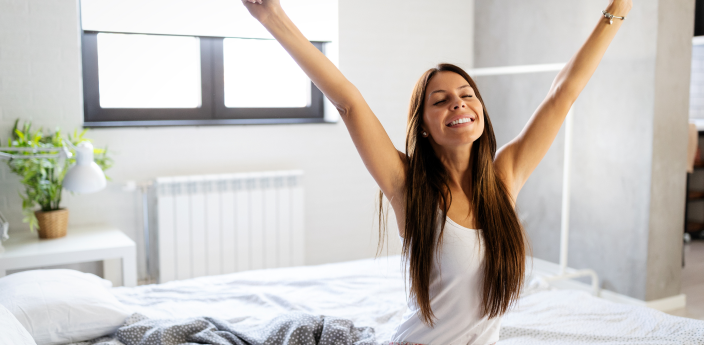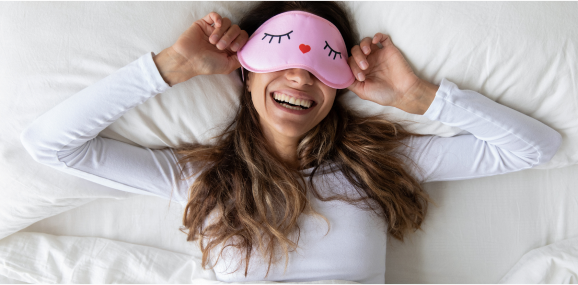Summer months mean fun-filled days, vacations, and cookouts. For some, they can also mean sleepless nights.
Many people find it difficult to sleep when the temperatures rise. If you’re already a hot sleeper, warmer weather can also increase feelings of stress about getting enough sleep.
When summer temps are in full force, many of us find it incredibly hard to get to sleep and stay asleep. This year, instead of suffering through the season and longing for fall, try these 11 tips collected by the Hug Sleep team to help you stay cool and get the rest you need.
The Perfect Sleeping Temperatures
It might seem elusive, but there really is such a thing as the perfect sleep temperature. According to experts, we sleep best when the temperature in our rooms is between 60 and 70 degrees Fahrenheit. Unfortunately, most of us don’t routinely keep our air conditioning set that low, even at night.
In hot weather, it’s even harder to keep indoor temperatures cool, which can cause an already overheating body to struggle with quality sleep.
Ideally, our bedrooms should feel similar to a cave: cool, dark, and quiet. Airflow is also important to help combat a hot, stagnant room. For hot sleepers and cold sleepers alike, a solid sleep environment is crucial to ensuring a good night of sleep.
What Happens When It’s Too Hot
If you’re not convinced that temperature matters, consider this. Research shows that there is a direct relationship between insomnia and core body temperature. If you wake repeatedly in the middle of the night, it could be because your bedroom temperature is too high.
The increased periods of wakefulness that can accompany a room that is too warm can disrupt your deep sleep and keep your body in a state of light, REM sleep, causing you to wake up feeling tired and groggy.
Don’t worry! It is possible to keep your cool, even when the temperatures soar into the 90s and above.
Our Tips for Sleeping Cool When It’s Hot
Even if you feel like you’ve tried everything to keep cool, we’ve got some unexpected ways you might not have tried yet so you can sleep as cool as an ice cube.
1. Release the Feet
We lose most of our body heat through the top and bottom, i.e. through our heads and feet. When you’re sleeping, your head is usually above the covers, but your feet are neatly tucked beneath a pile of bedsheets and blankets.
Pulling your feet outside of the blankets is a popular way to cool down — and it may even be preferable if you move around a lot during the night.
2. Adjust Your Core Body Temperature
Your body has its own thermostat, and you can do certain things to help adjust it. When it’s hot, taking a lukewarm shower before you hit the sack can help lower your body temperature and help you get ready to sleep.
Avoid taking a cold shower, as it can send your body into overdrive while attempting to warm back up. This can result in restoring your body temperature to the same place it was before you showered.
3. Become a Fan of Fans
If you already sleep with a fan, you probably understand how beneficial it is in keeping the air in your bedroom circulating. If not, a ceiling fan or box fan can help provide additional airflow that will keep you cool and help you get a good night’s sleep.
If you live in an area where a breeze is available, try an open window to help encourage air circulation. The fresh air at night might be cooler than the stuffy air in your house.
4. Avoid Certain Foods and Drinks Before Bed
Spicy pad thai may sound amazing at 8 p.m., but eating it that late could cause your body temperature to rise, making it difficult to sleep.
If you have trouble cooling down at nighttime, avoid drinking caffeine or eating spicy food or sugar immediately before bedtime. In fact, if you can stop eating a few hours before you hit the sack, you’ll have a better chance of slipping between the sheets with a lower body temperature, which can mean better sleep.
5. Dress for (Sleep) Success
Dressing for the job applies to sleep as well. Flannel pajamas might be the best solution for the winter months, but they can be murder during a heatwave. Instead, opt for breathable, lightweight fabric — and as little of it as possible — for nighttime.
If you tend to sweat at night, make sure to pick a material that doesn’t cling to your body when it’s damp.
6. Turn down the AC
Everyone likes a low energy bill, but room temperature is important for proper sleep. Paying a little extra for air conditioning in the summer months could mean the difference between getting a good night’s sleep and waking up tired.
It’s important to be energy conscious, so a good idea is to make a rule that you won’t turn down the air conditioner unless it’s a particularly hot night. Decide on a temperature in advantage, and when it hits, give yourself permission to lower the AC and improve your sleep environment.
7. Take It to the Floor
Heat rises, and during the summer months, the second story of your home can store hot air like an oven. If your bedroom is upstairs, consider relocating to a room on the bottom floor until the weather changes.
If you’re in a single-story dwelling, move your mattress to the floor. You’ll sleep peacefully below the hot air and wake up feeling better rested.
8. Forget the Flannel
Summer nights require cool bedding and sheets with extreme breathability. Heavy fabrics are too hot to sleep beneath.
Instead, opt for light cotton sheets and pillowcases. Egyptian cotton and bamboo are known for their ability to keep you cool at night.
Also handy is a cooling pillow, designed with material that is more breathable. Cooling pillows won’t retain body heat like down pillows and down alternatives.
9. Keep your Pulse Points Chilled
Showering in cold water might not help, but cooling down smaller areas of your body, called pulse points, can help lower your body temperature.
Pulse points are areas on your body where you can feel a strong heartbeat. These include your wrists and ankles, but also the backs of your knees and the insides of your elbows. Using ice packs on your pulse points for a few minutes before bed can lower your temperature and help you cool down before bed.
Feeling adventurous? Your groin is also a pulse point.
10. Drink Plenty of Water
Staying hydrated is crucial to your body’s ability to regulate your body temperature. In the summer, it’s easier for us to become dehydrated, especially if we are outdoors.
Rather than chugging fluids at night, make sure you drink enough water during the day to keep your body cool once evening hits. Downing a glass of water just before bed may seem like a smart solution to help you cool down, but you’ll really only cause yourself the irritation of waking up in the middle of the night to use the bathroom.
11. Throw off the Duvet
It’s challenging to sleep under a hot blanket during summertime — but it can also be tricky to drift off without the weight of your favorite blanket or duvet cover. If you throw off the duvet, you may not feel comfortable enough to sleep.
A solution? The Sleep Pod Move. Designed to keep you as comfortable as you would be in your regular bedding, the Sleep Pod Move is made with lightweight, breathable, four-way stretch fabric to keep you supremely cool.
By using the science of deep touch pressure therapy (DTPT) to naturally help your body transition from wakefulness to rest, the Sleep Pod can help your body and mind prepare for slumber.
Sleep and Your Nervous System
The nervous system is responsible for governing your awake times and your sleep times. In particular, the sympathetic nervous system (SNS) and parasympathetic nervous system (PSNS) help you stay awake during the day and prepare you for sleep at night. Here’s how.
- SNS. The SNS is responsible for keeping you awake and ensuring your senses are heightened. Feelings of stress and worry — but also the ability to make snap decisions when necessary — are all produced by the SNS. The SNS also triggers the release of the hormone cortisol, which can unfortunately keep our bodies in a fight-or-flight state even when it’s time for bed.
- PSNS. The PSNS is the chill cousin of the SNS. It triggers the release of both serotonin and dopamine, helping your body relax, and tells your heart rate to slow down. When our nervous systems work perfectly, the PSNS gives the SNS a high five towards the end of the day and helps prepare our bodies for sleep.
The problem? Many of us have sympathetic nervous systems that don’t clock out at nighttime. Shift work at odd hours, stressful life events, and certain pre-bedtime behaviors can cause us to stay awake when we should be getting ready for sleep.
Luckily, deep touch pressure therapy works to help move your body from SNS to PSNS. Think of it like switching on your internal GPS so it’s a little easier to get from Point A (wide awake) to Point B (blissful snoozing).
Why Sleep Pod Works
The use of DTPT to help your body relax comes to us from science. However, it requires a careful balance. Too much pressure can become uncomfortable, while too little pressure can lose effectiveness.
That’s why the Sleep Pod was tested (and retested, and then tested a few more times) to make certain we got it right.
With the Sleep Pod, you won't feel restricted or weighed down — a problem some people experience with weighted blankets. Instead, you’ll feel cocooned inside a cooling, stretchy blanket that hugs your body similar to a baby swaddle, for a sensory experience that is more soothing for most people.
Keep Cool With Hug Sleep
It might not be possible to keep your thermostat set to 60 degrees every night. But it is possible to get great sleep even when the outside temperatures are high. Be smart, use good air circulation, and make sure you’re taking measures to cool your body down before bed.
When it’s time for rest, ditch the heavy bedding and grab the Sleep Pod. You’ll stay cool, feel embraced, and look forward to bedtime every night.
Sources:
The Best Temperature for Sleep | Cleveland Clinic
Effects of Thermal Environment on Sleep and Circadian Rhythm | National Library of Medicine
The Relationship Between Insomnia and Body Temperatures | PubMed

































500,000+ happy customers